Corvid-19 Crisis and Possible Future:
Society, Business, Innovation, and TRIZ
Original Title: Mapping the Un-Mappable: The History Of TRIZ 2020-2030
Darrell Mann,
Presentation at TRIZCON2020 (Oct. 6-7, 2020, USA, Online)
|
|
Corvid-19 Crisis and Possible Future: Original Title: Mapping the Un-Mappable: The History Of TRIZ 2020-2030 |
|
|
|
| Posted: Jan. , 2021 |
For going to Japanese pages, press buttons.
Editor's Note (Toru Nakagawa, Dec. 31, 2020)
This page posts the presentation by Darrell Mann at TRIZCON2020, in its full form of the slides together with the speech text transcript-ed later thoroughly by the presenter himself.
I also have translated the speech text into Japanese and am now going to post the presentation in the Japanese page of this site, even though the slides are still in English.Darrell Mann wrote a paper, extending this presentation slightly, and publicized it in the Oct. 2020 Issue of his e-Zine. And I posted it already in English
and in Japanese translation
(Nov. 25 2020). There he describes that the serious global crisis triggered by the Covid-19 would continue to effect for 4-5 years and discusses about the directions toward the TRIZ community should struggle in order to help genuine innovations. In the presentation, he shows various models developed recently by a number of wise people besides himself as the basis of his thoughts. This is an important talk indeed showing his thoghts in the current stage of the global crisis period.
At the bottom of this page, my Editor's Note (PS) is added to record how the present postings were realized (with some overlap of our previous posting on Nov. 25, 2020).
Table of Contents (of the present page and Darrell Mann' presentation)
Documents are accessible in the following sites and pages:
Table of Contents of Darrell Mann's Presentation:
[Note (TN, Jan. 1, 2020): Mann's presentation is very well organized. Since it's 47 slides long, however, a tabla of contents would be useful for us readers. And I dare to set a new title besides the original one in order to clarify the author's intention, In the text, I incerted a number of CR/LF and bold faces, for better readability.]
Corvid-19 Crisis and Possible Future: Society, Business, Innovation, and TRIZ
(Original Title: Mapping the UN-Mappable: The History Of TRIZ 2020-2030 )Outline; Hypothesis on seeing the future; Unknowable on Covid-19?
1. Society (Societal Level Challenges)
We saw this coming (with the Generation Cycle Model); ibid (with Domino effect);
Crisis periods with wobbling dominoes; Where we are now (in the Generation Cycle Model); Crisis Period;
Where we are now (with the Hero's Journey Model);
There are always Winners in a crisis; Disaster Cycle Model;
Societal Scenarios 2020-2025 (Dmitry Orlov's 5 scenarios); 2030 Scenarios (with our 2×2 framework);
There are always Winners in a crisis (Winner industries); There are always Losers too ...;2. Business (Business Level Challenges)
Map of the World (with Complexity Landscape Model (CLM));
The 20th century business paradigm (Efficiency triangle in CLM);
2012... The world gets a new Word ('AntiFragile' by Nissim Taleb);
'Natural' Forces in CLM; Management in CLM; Complex change -- The Golden Triangle (in CLM);
The Hero's Journey (in CLM);
20th century business (Paradigm, problem, and principle); 21st century business;
Three types of enterprise (K-shaped 3 patterns); ibid (examples of enterprises);3. Innovation (Innovation Level Challenges)
The consulting world (the Big Five);
Defining Innovation ('Ideas', 'Implemented ideas', vs 'Successfully implemented ideas');
Innovation Capability Maturity (our ICMM model);
98 % of XXX-method-sparked innovation attempts fail; What did the 2% do ? (our research);4. TRIZ (TRIZ Level Challenges)
TRIZ & the Hype Cycle (with Gardner's Hype Cycle Model);
TRIZ's place in the world (in CLM model); ibid (TRIZ 1.0 or Classical TRIZ);
ibid (TRIZ/SI 2.0, TRIZ/SI 3.0, TRIZ/SI 4.0);
Where the world is (in CLM, various methods in TRIZ/SI 4.0);
Winston Churchill saying ... (on Democracy, on TRIZ);
TRIZ Yes, Buts... (4 principal issues);
TRIZ 2030 Prognosis (4 principal directions);
Thanks
| Documents accessible | Table of Contents of the Presentation | 2. Business Level Challenges |
3. Innovation Level Challenges |
Editor's Note (PS) | Slides PDF |
![]() Talk (full presentation) ==> Slides PDF
Talk (full presentation) ==> Slides PDF
Corvid-19 Crisis and Possible Future: Society, Business, Innovation, and TRIZ
(Original Title: Mapping the Un-Mappable: The History Of TRIZ 2020-2030)
Darrell Mann, Presentation at TRIZCON2020 (Oct. 6-7, 2020, USA, Online)
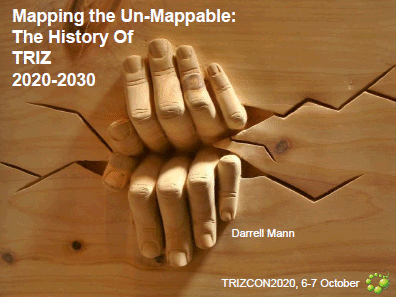 |
Hello, TRIZCON. Long time no speak. Great to be a part of this years conference and to share with you some of the things we've been doing with our clients this year. Helping them to make sense of the world we now all live in, and to see what's likely to happen in the coming years. |
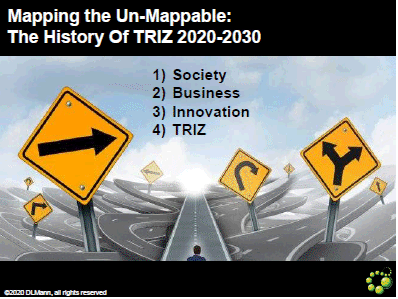 |
I've got four parts to the presentation. |
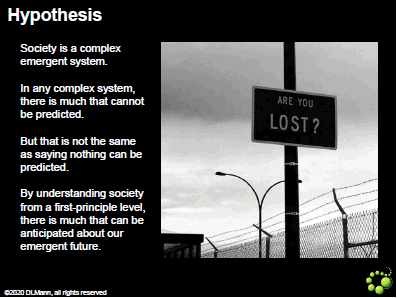 |
As soon as we say we're going to try and predict the future, then we're in fundamentally complex territory. Which means that there are an awful lot of things that we can't know about what's going to happen. But at the same time as that, we know that's not the same as saying there is nothing we can know about the future. |
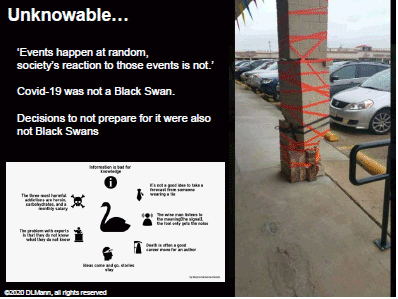 |
A big part of the problem of predicting the future is the 'Black Swan' side of the story. This relates to the Nassim Taleb concept of the highly unpredictable, high consequence event in life. What we know to help us on such a journey is that even though events happen at random, society's reaction to those events is conditioned by fundamentals associated with the behaviour of human beings. And so, if we can build that stuff into our prediction models and our evaluation of what's happening then we stand a pretty good chance of identifying some of the key things that are likely to be ahead of us. Ironically, perhaps with the Covid world that we now live in, Covid was not a Black Swan, but rather a highly predictable event. And really the only surprising part of the story, perhaps, is the fact that so few Governments decided to prepare for the pandemic. And then, because of that lack of preparation, as soon as you see that has happened, it sets in place a sequence of events that are now unfolding. |
1. Society (Society Level Challenges)
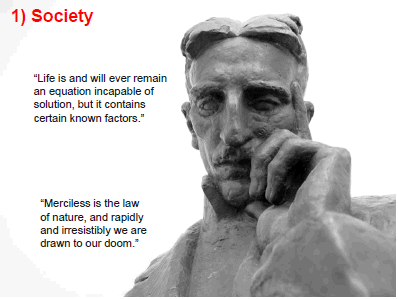 |
Let's start with the Societal level perspective. |
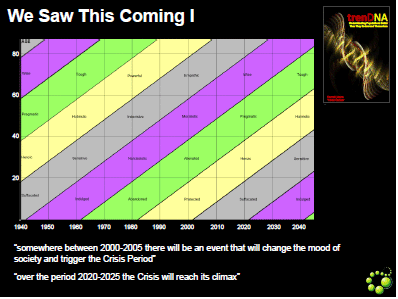 |
At the Societal level, what's happening at the moment is completely consistent with some of the things we talk about in the TrenDNA book, and in turn, where we got that from was the work of Strauss & Howe looking at generation cycles. I think they're a little bit mis-understood in that they're perceived as being top-down analysts of the world, whereas in actual fact, the premise of their work was very much a first-principles idea. One which says the way you were raised by your parents will impact the way you raise your own children should you choose to have them. This model tells us that the years 2000-2025 is a Crisis period if the previous pattern is allowed to repeat. And, so far it has done. We'll dig a little bit deeper into that in a second. I'm conscious with this presentation that I've got a lot of material to try and cover and so the way I'm trying to handle that is by providing, as you'll see on the bottom of a lot of the slides, a reference for further reading. We've published a lot of material this year, and if anyone's interested in any particular part they can go and look at whichever bits they feel they'd like more information on. |
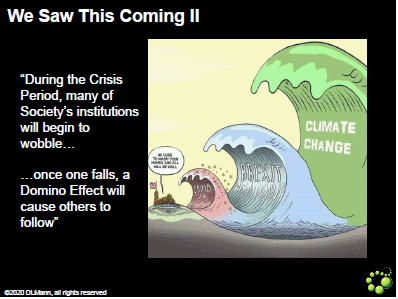 |
We also know that there are an awful lot of things we can't predict as described earlier. We do know that in the Crisis period there are lots of wobbling dominoes. And while it's difficult to predict which domino will fall over first, once one domino falls over it gives us a good indication of what the next domino and the domino after that will be to fall over. |
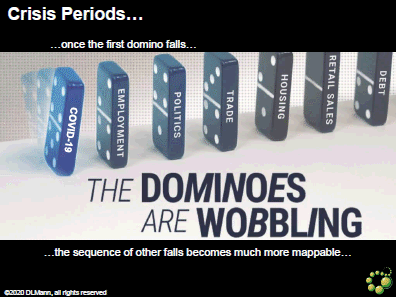 |
So, whether it's trade, employment, politics, we're now in a situation where the pandemic has already severely impacted other dominoes and we're starting to see some of those also falling over. |
|
Right at this moment we're coming to the climax of the Strauss & Howe predicted Crisis period, and, if the pattern plays out, it tells us the next four-to-five years, things will get worse than where they are today. And then hopefully, somewhere around 2024/2025, things will settle down into a 'New World'. In effect what the model says is that the world is currently in transition from one s-curve to the next. |
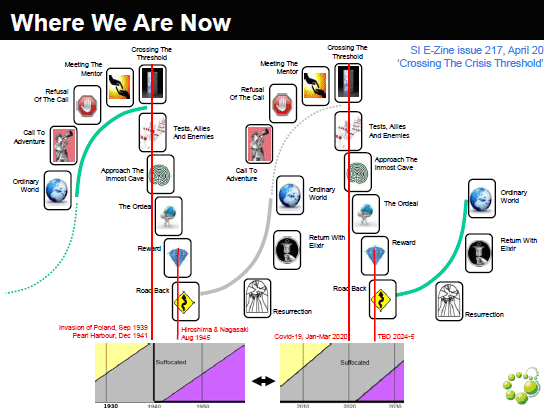 |
Another model that's useful in these kinds of situation is the Hero's Journey. Here, as soon as we understand there is an s-curve shift taking place, the work of Joseph Campbell tells us that there are some clear milestones that occur during those transitions. One of the key ones being that, once we've jumped off an s-curve, there will be an 'Ordeal', or, from a TRIZ perspective, a contradiction that needs to be solved. Trying to look at previous cycles of the pattern and where we are right now, the analogy I would draw is that the pandemic is the equivalent, in the US at least, of Pearl Harbour in the last cycle. Pearl Harbour was a clear signal to the United States that their current way of living wasn't going to prevail any longer, and triggered the start of a transition to a New World. So, right now with Covid, if the pattern repeats, then we have four or five years to unravel the Ordeal, make sense of it, solve the problem and – hopefully – solve it well. |
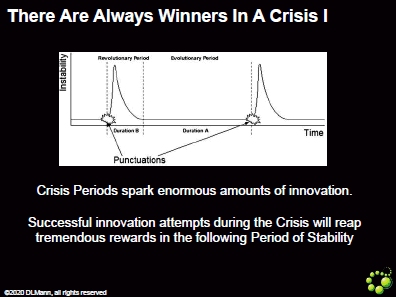 |
We also know that we're in a situation here of 'punctuated equilibrium'. So, for large periods in history, things are relatively calm. Then one domino will fall over, and it will trigger the fall of a number of other dominoes and we'll see lots of change, and then things will settle down again. So, again, right now we're in one of those punctuated equilibrium situations. And one of the things we know from previous cycles is that these periods of instability are really important from an innovation perspective. |
|
Here's another model of the world offering a classic case of someone, somewhere having done some hard work for us. This is the Disaster Cycle. A piece of knowledge concerning the occurrence of bad events, that what follows from them forms a very consistent pattern. So, we have the impact of the event, |
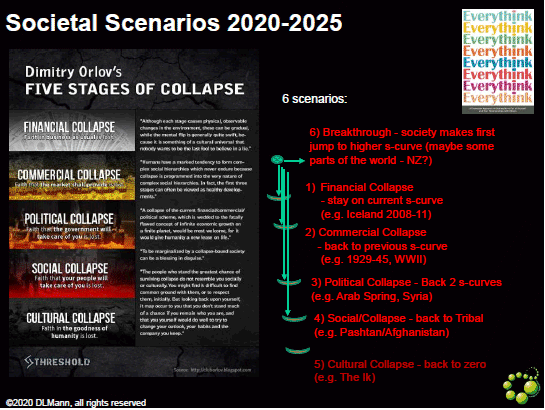 |
This is another piece of research looking at the world from a societal perspective, and again, looking at disaster and situations where society jumps off its s-curve. This is the work of Dmitry Orlov. His scenarios for the world where it is now are all quite bleak to be honest. The best of which is that we do what Iceland did at the end of the GFC and thus allow ourselves to stay, or return to where we are. He didn't have one of the good scenarios that we think is a possibility. We just published the 'Everythink' book, and that talks about a breakthrough situation where we jump to a 'higher' level s-curve than the one we're on right now. We think it's a fairly low probability, but its not possible to say at this point in time which of those scenarios, whether it's the optimistic one that we've got, or the five pessimistic ones that Orlov has got, is the one that will happen. I think what we do have though is the opportunity to identify some of the signals that will tell us which of those scenarios is the most likely to play out. |
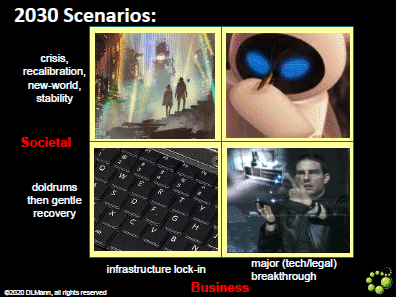 |
In order to make any kind of meaningful prediction about the future, we need to take all the uncertainties and try and bracket them. So, what we've done with several clients this year is build a number of scenarios which together cover the range of possible changes in the world. In this picture here we're essentially looking at four scenarios along two different axes. One looks at society – which either stays in the doldrums that its in right now or it undergoes a significant step-change. And on the other axis we look at the world of business and again have one scenario that says the current systems remain locked-in where they are right now, or, at the other end of that spectrum, there's some kind of a major breakthrough. That could either be a technological breakthrough (for example the energy sector, probably the most likely), or its some kind of legislative breakthrough and shift. The most likely scenario there, I think, is the power of the Big Data companies and the likelihood that Governments will try and break them up. So, we look at those four scenarios and then, if we identify something that occurs in all four scenarios, then we can say with a degree of confidence that its likely to happen whatever the reality turns out to be. We've done that analysis. I don't have time to go through it here, but… |
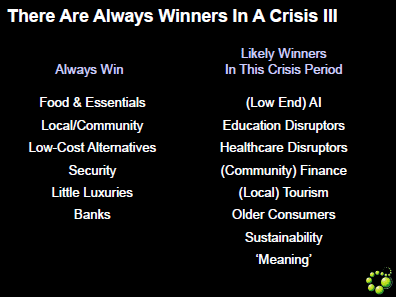 |
Pointing out what we have seen from those scenarios is that in Crisis periods, whatever the scenario turns out to be, looking at those four extremes, there are always winners, winners that are consistently winners, and then there are winners that are likely to be winners in this particular cycle. The headlines on the slide are essentially the findings that we've published, and we think are going to inform the innovation side of our story. |
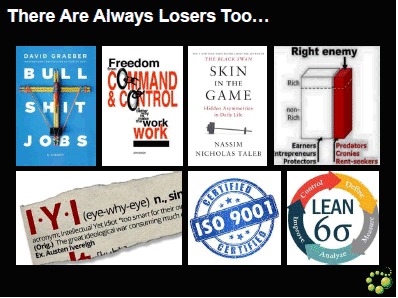 |
It's sometimes nice to look also at some of the losers. Without wanting to get too depressing about things, there's a few references I think give us some signals. One of the most likely ones is, looking at the book, 'Bullshit Jobs' by David Graeber, who sadly passed away recently. During Crisis periods a lot of those meaningless jobs that currently exist in the world will disappear. That could mean 30% of the jobs in the world according to Graeber's research. I think also highly likely is the fact that when we're in a period of chaos and high instability, optimisation is not the right strategy anymore, and so things like Lean, SixSigma will fade into the background. Providers of those kind of services are going to have a tough time. |
2. Business (Business Level Challenges)
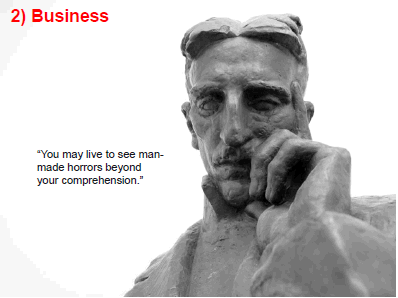 |
Let's now zoom in and look at the world of business… |
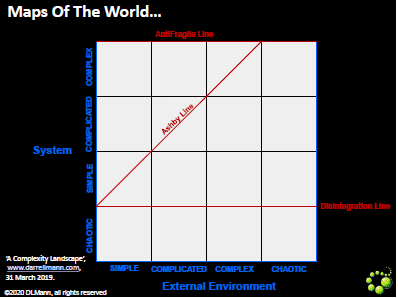 |
…and introduce this model [Complexity Landscape Model (CLM)]. Again, it's all written up elsewhere so I'm not going to spend too much time describing it here. One of the things that we've been saying quite strongly to our clients is that you need to understand the capability of your organisation in terms of complexity, and you need to set that in the context of the surrounding environment that you've got. So, you've basically got four scenarios you need to be thinking about. |
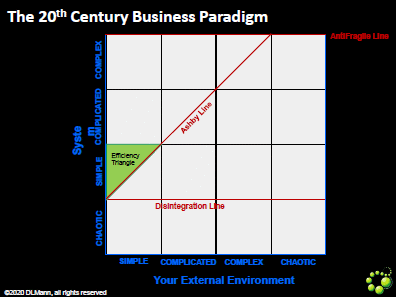 |
…One thing we know from before the pandemic hit is that the prevailing business model for most organisations was efficiency-driven. And so what that meant was a desire to simplify things inside organisations… |
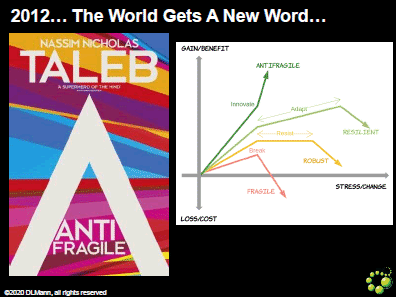 |
…ever since Taylor came along and studied work, 'standardisation' has been the dominant model. |
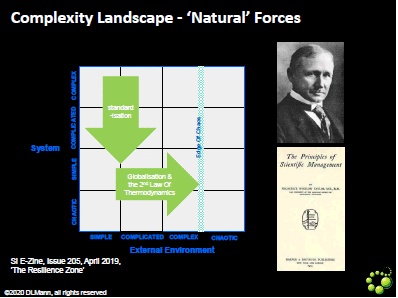 |
…that's the line at the top of the 4-by-4 picture. The natural world tries to take us away from this line. So standardisation and Taylor's work tries to simplify everything; the 2nd Law of Thermodynamics and the reality of life push us towards the boundary with chaos. Both these forces combine to make it difficult for organisations to get to where they'd like to be… which is where they are 'efficient'… |
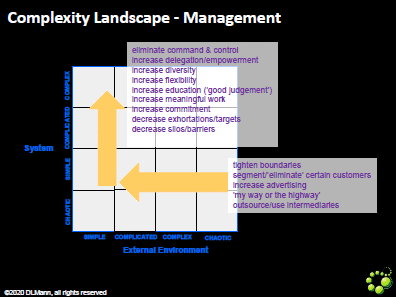 |
…there are certainly things we can do in order to achieve that. Some of them quite drastic – for example, if we look back at the beginning of the automotive industry and Henry Ford, 'any colour you like as long as it is black' was a great way of simplifying their market. If you wanted to buy a Ford, it was going to be one that had a black paint-job. |
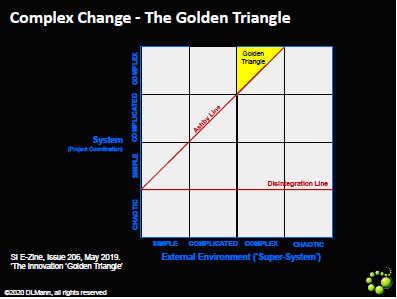 |
Where you'd like to be, where Taleb encourages us to be is up in the 'Golden Triangle' at the top of the picture. That's the place that says we acknowledge the world is complex, and we have processes in place inside our organisation which are consistent with that complexity. Above the diagonal line – the Ashby Line – says that the capability of our system is greater than the level of complexity of the world around us. Hence it makes a great target for organisations to be. The distance between the previous green triangle, the Efficiency Zone and the Golden Triangle, unfortunately, makes life quite difficult for most organisations. It's a big shift that needs to take place... |
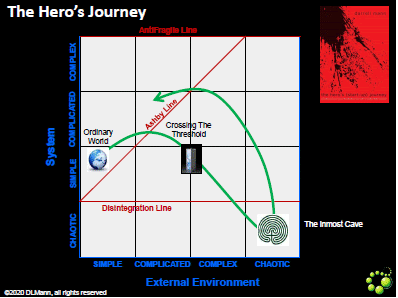 |
…the book ("The Hero's Journey") we published at the beginning of lockdown is all about start-up companies, but it's also about the journey of getting out of the 'ordinary', efficiency-dominated world and into a complex environment. Almost fundamentally that means going through a period of chaos. I think many people will recognise that the world only really changes when we are in such a situation of chaos. Because, if nothing else, chaos teaches us that the existing rules don't apply any more. |
|
I think, just looking at business, and how it's changed by this s-curve shift that society is taking, there's another book that has come out recently, which we think is relevant. That is Gary Hamel's latest book, 'Humanocracy'. It talk about a shift in paradigm that's taking place in the workplace. He's another person who understands 'first principles'. Humanocracy in effect talks about the shift that is taking place away from the efficiency-dominated world in which people employed by organisations are effectively given tiny, segmented, easily-trainable jobs… into one in which efficiency shifts to effectiveness, and where we need people to bring their brain to work and to think creatively. Now, whether that creates any innovation opportunities remains to be seen, but that paradigm shift is certainly something we can see on the horizon… |
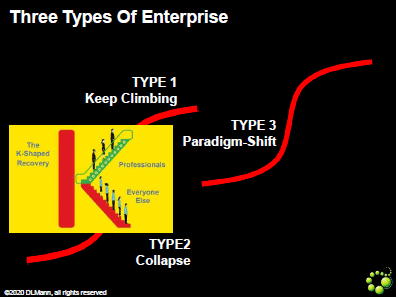 |
…I'm not sure every organisation is going to be able to make it. I'm not sure many actually want to make it. If we look at what's happening in the media at the moment, there's lot's of talk about a K-shaped economy. All of our scenarios predict the same thing. Which basically means that we've got three types of organisation: |
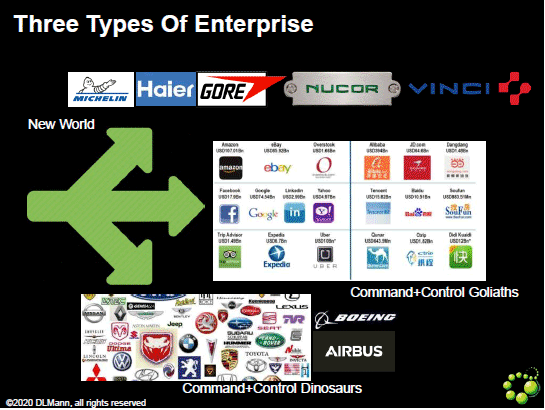 |
I think there are clear signals, and certainly looking at Hamel's book we can see examples of these 'new world' organisations – where they've engineered completely different organisation structures: structures that are consistent with empowering people, eliminating the 'bad' jobs, creating 'self-organisation'. In many ways, very consistent with TRIZ. Haier, WL Gore are the two prime examples of what the new world could look like. The 'command and control', Type 1. Organisations, those are the Facebooks, the Amazons of the world, the ones that have become highly dominant in the past decade or so because they've tapped into the virtuous cycle that comes from owning peoples' data and using that data to better understand what it is that customers will want in the future. And then, the Type 2 downside sees the 'command and control' dinosaurs, the top-down driven organisations… I think automotive is going to be one of the biggest sufferers in this domain. Aerospace not far behind it. Unless these companies are able to make a marked transition to a new way of doing things then they're going to be in serious trouble. |
3. Innovation (Innovation Level Challenges)
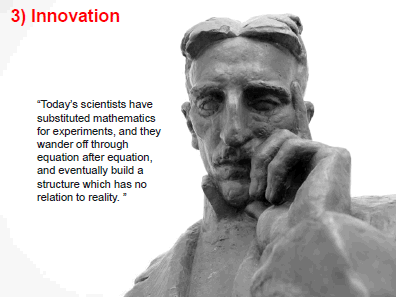 |
From an innovation perspective then, what have we heard so far? |
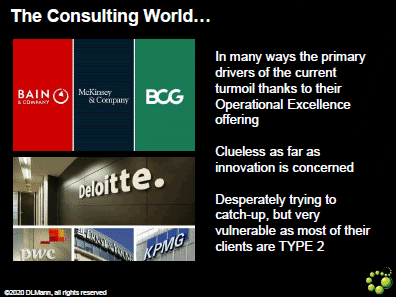 |
…to enable it? Certainly if we look at the Big Five consulting companies there's a strong case to be made to say that they're the cause of the problem that the world's in right now, because what they've been doing is teaching client companies about operational efficiency for the last 40 years, and have taken companies too far down that efficiency road. To the point where many of them are unable to come back and rethink how they do things. We think they're in trouble. We think there are signs, if you look at the companies the Big Five consulting companies are buying at the moment – e.g. buying 'Design Thinking' boutiques and innovation boutiques – its clear they fundamentally don't understand what innovation is about yet. They could be a solution in the future, but in the short term are very definitely not going to be… |
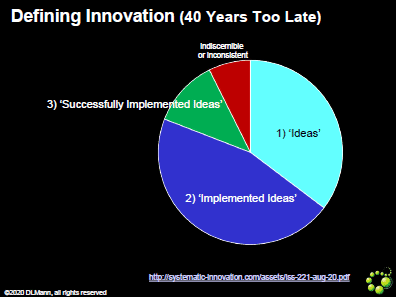 |
…part of the reason for that is there is still an awful lot of confusion about what we mean when we use the word 'innovation'. We published this article a couple of months ago looking at the different definitions that are out there. The one that we use is the one that defines innovation as 'successfully implemented ideas'. In other words, it is making money for the organisation. But it turns out that our view represent s a minority perspective on what innovation means. |
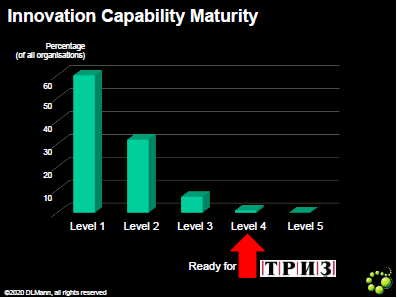 |
Something we've known for a long time is that TRIZ over-shoots the market to a high degree. It was 2012 when we published the Innovation Capability Maturity Model, where we'd identified five different Levels of Capability to innovate inside organisations. TRIZ really becomes a valuable tool for Level 4 and Level 5 organisations, but, as shown in this picture here, there aren't many of those organisations. The majority of organisations have never really had to think about innovation, and so have really been thrown in at the deep end when the Covid domino fell over. This is a problem for the TRIZ World… a lot of the tools are useful, but actually quite dangerous if the Capability to innovate inside the organisation is low. |
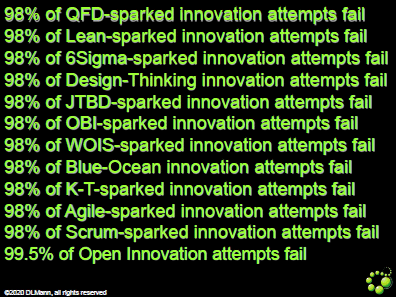 |
What do we also know? We know that other methods struggle similarly to deliver success inside organisations. So, 98% of all innovation attempts fail. And if we look at innovation attempts that purportedly use Design Thinking, Or QFD, or Open Innovation, they really do nothing to impact the overall success or failure rate. The problem is something deeper than methodology. We could easily add TRIZ into that story too. It's a necessary part of the innovation story, but it's not a sufficient part when we're dealing with complexity. |
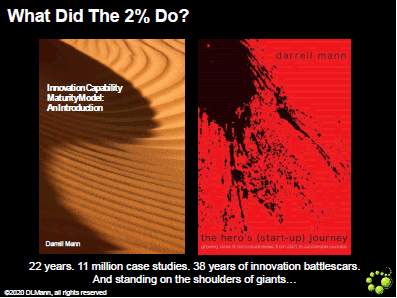 |
So, what we've tried to do over the years, we did it with the Capability Maturity Model back at the beginning of the last decade, is try to look at the 2% of organisations that were successful, and reverse engineer what they did. This year's book, the Hero's (Start-Up) Journey is really been about the start-up organisations and the 2% of those that are successful, and reverse engineering what is it about their capabilities that allow them to succeed where their competitors did not. |
4. TRIZ (TRIZ Level Challenges)
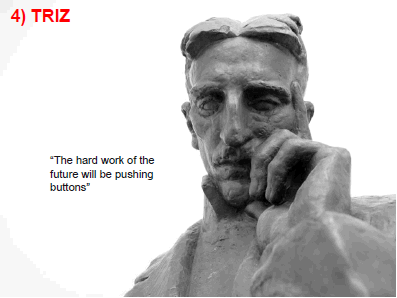 |
So that takes us to TRIZ. |
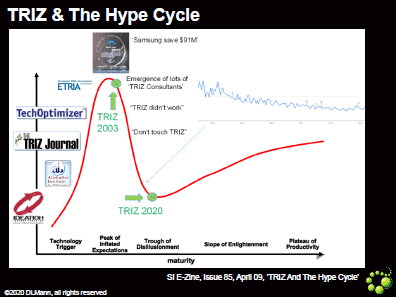 |
…'necessary but not sufficient' is the way we've been describing it for a number of years. Some of you may be familiar with the 'Hype Cycle' from Gartner. We've been tracking TRIZ's along this Cycle for a number of years. It makes for a great case study. One we've written up a couple of times now, looking at some of the key events that took place in the 1990s – the arrival of the first consulting companies, the software, and the deployment inside companies like Samsung. The pinnacle of TRIZ so far was probably the Samsung medal awarded to the TRIZ team. Everything after that has seen TRIZ on a downward trajectory, completely consistent with what the Hype Cycle tells us. I'd have to say, where we are right now is right at the bottom of the 'Trough of Disillusionment'… which is a dangerous place to be. Ideally, we get through it, and up the 'Slope of Enlightenment' – so people begin to understand what TRIZ actually does, But, when you're in the steep downward trajectory, sometimes it's the case that we can't climb out of the descent fast enough and we end up crashing everything completely. |
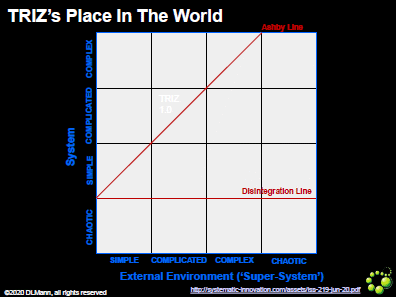 |
So, what do we conclude from our analysis? The answer takes us back to our Complexity Landscape again. One of the reasons why TRIZ has struggled s because if we look at original, Classical TRIZ… |
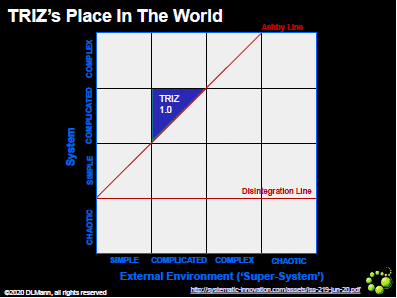 |
…it really sits in the 'Complicated' domain. It's not designed for complex problems, but rather, complicated technical problem where the system is in control. The clue is in the name – 'theory of inventive problem solving – it tells us something about the problem, but the crux of the method really resides with the problem solving part of the story… |
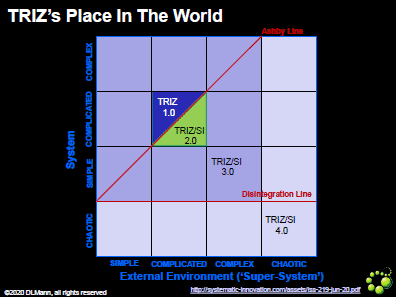 |
…it's only later on when we have what might be called, TRIZ 2.0, where we start to bring in some of the Western influences. So, Function Analysis gets added to the story, for example, and it's then that we can look at complicated problems where the definition is very unclear. What we've been trying to do is, because of the work we do with marketing functions and looking at 'business' is create a TRIZ 3.0, or, more appropriately, 'Systematic Innovation' these days, is to get into that complex world such that we can deal with complex situations. The idea here is, again, diagnosing where an organisation is and then bringing along the appropriate sets of tools and methods for that particular situation. So, if it's a complicated situation then Classical TRIZ is a perfectly adequate, and a perfectly sensible thing to bring to the story. If you're in a complex environment then, unfortunately, Classical TRIZ is really not going to help you. It will point people in fundamentally wrong directions. What's required is to acknowledge and embrace the complexity that's there. When we're dealing with chaos, what that essentially means is that we have to be able to do things an awful lot faster… |
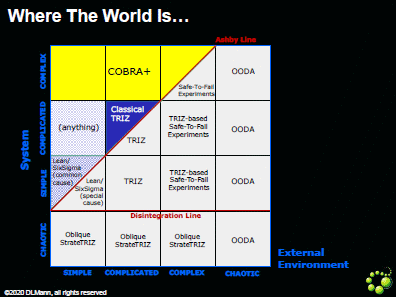 |
…and so when we start attaching methodologies to these different scenarios then, in the Chaos world, we're looking at the work of John Boyd and his OODA model – the idea of rapid learning cycles, which may well have a TRIZ element to them, but it is the cycling and the rapid learning that is the key to survival and thriving in those environments. The model basically gives us an indication that, once we've understood where an organisation is and where their market is, we get a much better chance of bringing along the right combination of tools and methods to deal with the situation. |
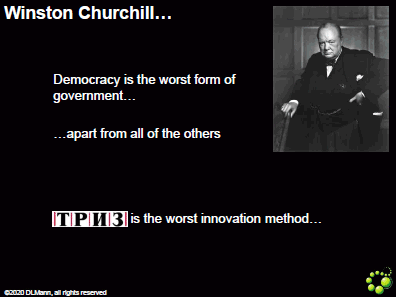 |
As far as TRIZ itself is concerned, then, I've used this slide way too many times in recent years. The UK has some of the worst politicians on the planet at the moment. Historically, we've had some of the best, and I think, the best was probably Winston Churchill, who, famously talked about democracy as being the worst form of government… apart from all the others. I think TRIZ finds itself in a similar situation, in that it is the worst innovation method… apart from all the other ones. This is a problem. It's certainly a problem for the TRIZ community. But it's a problem for organisations that are trying to innovate also, because there's a lot of stuff out there – with 1500 books a year published on innovation – and none of it really seems to help… |
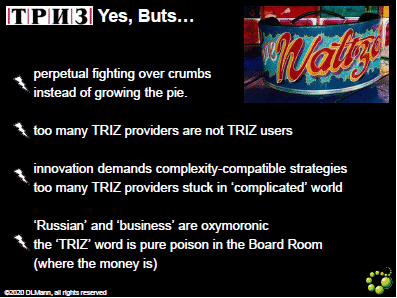 |
…so, the prognosis for TRIZ … what are the 'yes, buts' first of all? A constant frustration, certainly inside our organisation, is the bickering and argument that still takes place in the TRIZ world. Fighting over crumbs instead of growing the pie. I look at some of the Big Five consulting companies that have got zero innovation capability, and the TRIZ world really should be destroying those organisations. And yet, here we are, literally scraping a living, especially those that are trying to do it with purely TRIZ. There are too many TRIZ providers… many of whom are not users of TRIZ. Again, it's an enormous frustration of mine that TRIZ tells us the customer wants the function, and still we hear TRIZ consultants saying you have to use TRIZ. It's completely inconsistent with the reality of the world and, because a lot of the TRIZ providers aren't innovators – they've never innovated, they've never seen a project all the way through to its end, its really difficult for them to understand the complexity of the world, especially the 99% perspiration that follows the 1% inspiration at the beginning. |
|
|
||
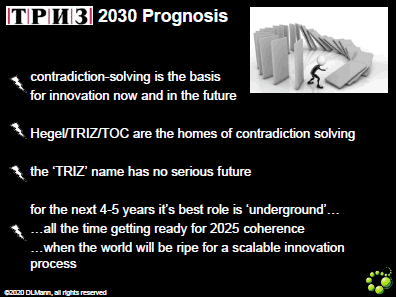 |
Fundamentally, I think we can say very safely that, when we take things down to a first principle level, innovation is largely about contradiction solving. The vast majority of all innovations – in other words the 2% that have been successful – they've identified and they've solved a contradiction. TRIZ is the absolute home of contradiction-solving. Theory of Constraints is perhaps the only other methodology that gets anywhere close to it. Recognising the importance of contradictions, philosophically speaking we're looking at Hegel and his insights about the importance of contradiction solving. So, the good news as far as the TRIZ community is concerned, is that, whatever happens, when the world understands that innovation is contradiction solving, TRIZ has an enormous advantage over just about everything else. |
|
|
||
|
So, a mix of good and bad news. Thanks again for the opportunity to let me speak. I'm conscious that I've thrown lots of information at people. If anyone wants to know more information, I'm always happy to start a conversation. Either through email or, these days, through Twitter. Enjoy the rest of the conference, and thanks very much. |
Editor's Note (PS) (Toru Nakagawa, Dec. 31, 2020)
The video record of Mann's presentation was submitted to the Altshuller Institute last September for the preparation of online TRIZCON to be held on Oct. 6-7, 2020. I also sent my presentation video of the WTSP project. Since Altshuller Inst. was allowing for the presenters to access to the videos by other presenters, I had a chance of watching Mann's video. On watching his presentation twice, I recognized its importance. So, on Sept. 20, I asked Altshuller Inst. and then the author for me to translate Mann's presentation into Japanese and to post both English and Japanese editions in "TRIZ Home Page in Japan". A.I. and the author willingly agreed, to my thanks. Transcripting the author's fast and colloquial speech was the first and most difficult job for us in Japan.
On Oct. 3, Darrell kindly sent me a preprint of his paper extending
the TRIZCON speech. Thus, on Oct. 26-30, after the Conference, I worked for Japanese translation of the paper (which Darrell publicized in his Systematic Innovation e-Zine on Nov. 2). I have posted his paper on Nov. 25 both in English and in Japanese
in my web site, with some detailed Editor's Note.
He sent me the full transcription of his TRIZCON presentation, with slight rephrasing, on Dec 13. It's a really big help for me. I struggled with its Japanese translation, and finished making the body of the present pages both in Japanese and in English only today, the last day of 2020. The 47 slides are not translated yet, but I am going to post the pages early in the new year, because the earlier the better for Darrell Mann's important and excellent presentation to be known widely.
I am very grateful to Altshuller Institue and the Author, Darrell Mann, for their generous permissions of my posting these pages.
| Documents accessible | Table of Contents of the Presentation | 2. Business Level Challenges |
3. Innovation Level Challenges |
Editor's Note (PS) | Slides PDF |
Last updated on Jan. 5, 2021. Access point: Editor: nakagawa@ogu.ac.jp